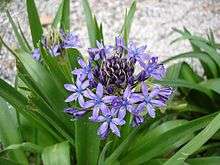Scilla peruviana
Scilla peruviana, the Portuguese squill,[2] is a species of Scilla native to the western Mediterranean region in Iberia, Italy, and northwest Africa.[1][3]
| Portuguese squill | |
|---|---|
 | |
| Scientific classification | |
| Kingdom: | Plantae |
| Clade: | Tracheophytes |
| Clade: | Angiosperms |
| Clade: | Monocots |
| Order: | Asparagales |
| Family: | Asparagaceae |
| Subfamily: | Scilloideae |
| Genus: | Scilla |
| Species: | S. peruviana |
| Binomial name | |
| Scilla peruviana | |
| Synonyms[1] | |
|
Many, including:
| |
Although the epithet peruviana means "from Peru", it is strictly a western Mediterranean species. Linnaeus named the species in 1753, citing an earlier name given to the plant by Carolus Clusius, Hyacinthus stellatus peruanus.[4] Clusius mentioned the species as growing in the Antwerp garden of a certain Everardus Munichoven, who reportedly got the plants from Peru.[5] The error was already mentioned in 1804 in Curtis's Botanical Magazine.[6] There is no reliable source for the story about a ship named 'Peru', shipping plants from Spain to Northern Europe, misleading Clusius or Linnaeus into giving the erroneous name.[7]
It is a bulb-bearing herbaceous perennial plant. The bulb is 6–8 cm diameter, white with a covering of brown scales. The leaves are linear, 20–60 cm long and 1–4 cm broad, with 5-15 leaves produced each spring. The flowering stem is 15–40 cm tall, bearing a dense pyramidal raceme of 40-100 flowers; each flower is blue, 1–2 cm diameter, with six tepals.
Cultivation and uses
It is commonly grown as an ornamental plant for its spring flowers; several cultivars are available ranging in colour from white to light or dark blue, or violet. In some areas it is also known as hyacinth-of-Peru,[3] Cuban-lily,[3] or Peruvian scilla.
References
- "Scilla peruviana L." Plants of the World Online. Royal Botanic Gardens, Kew. Retrieved 2020-05-17.
- "BSBI List 2007". Botanical Society of Britain and Ireland. Archived from the original (xls) on 2014-10-23. Retrieved 2014-10-17.
- "Scilla peruviana". Germplasm Resources Information Network (GRIN). Agricultural Research Service (ARS), United States Department of Agriculture (USDA). Retrieved 30 June 2013.
- Linnaeus, C. (1753). Species Plantarum. Stockholm: Laurentius Salvius. p. 309.
- Clusius, C. (1601). Rariorum plantarum historia. Antwerp: Plantijn Moretus. p. 182.
Clusius writes: Primum autem locum merito sibi vindicabit elegant et rarissimus ille, quem, ex Peruano orbe delatum, in suo horto alebat Everardus Munichoven et florentem suis coloribus exprimi curabat. A French translation of it is to be found here: Cette [Hyacinthus] élégante et très rare, rapportée de la région du Pérou, que cultivait dans son jardin Everard de Munich[oven] (à qui cette étude tient à coeur) et qu'il soignait en fleurs pour ses couleurs parmi les plus belles. - Sims, J., ed. (1804). "Scilla peruviana". Curtis's Botanical Magazine. 20: 749.
- O'Hara, S.A. (2019). "What's in a Name – Scilla peruviana". Website California Horticultural Society.